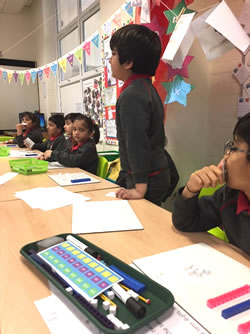How the NCETM's mastery materials are making an impact
How our Professional Development materials can help you consolidate your subject knowledge, plan your maths lessons effectively and be assured that your pupils will grasp concepts with confidence
06/09/2019

Want to consolidate your subject knowledge, plan your maths lessons effectively and be assured that your pupils will grasp concepts with confidence? Use the NCETM Professional Development materials, say Kathryn McGregor and Michelle Addison at Lammack Primary School in Blackburn.
 There are observations that apply to most teachers as the new academic year starts. Firstly, they have already spent much of the summer thinking about what they will be teaching and how to engage and inspire a new class. Secondly, they have not had quite enough time to do everything they want, including planning - in advance - whole series of lessons which are challenging, fun and well-pitched for all learners.
There are observations that apply to most teachers as the new academic year starts. Firstly, they have already spent much of the summer thinking about what they will be teaching and how to engage and inspire a new class. Secondly, they have not had quite enough time to do everything they want, including planning - in advance - whole series of lessons which are challenging, fun and well-pitched for all learners.
This is where the professional development (PD) materials come in. The materials comprise a teacher subject guide and animated PowerPoint slides. The guide breaks down content into Teaching Points, and exemplifies each with details of representations, classroom routines, stem sentences, suggested resources and clear instructions, so that children grasp concepts securely. The PowerPoints illustrate the topics in the guide and provide an engaging visual anchor for pupils’ learning. Instead of being a lesson plan or set of resources, the materials ensure that teachers’ own professional development needs are foregrounded. Consequently, teachers deliver maths lessons having deepened their subject knowledge, and give pupils the best chance of building secure mathematical understanding.

During a visit to Lammack Primary School in Blackburn, we had the chance to see the materials in action. Lammack is a large and successful primary school with approximately 500 pupils on roll. In the lesson we saw, Michelle Addison took her Year 1 class through numbers 20 to 100, exploring the relative size of two-digit numbers. Learning included the class counting together in tens, exploring place value, and drawing pictorial representations of their understanding. After 30 years teaching other year groups, Michelle started teaching a Year 1 class for the first time in September 2017, and Kathryn McGregor (Assistant Head and Maths Lead) recommended the NCETM PD materials as a way to think about approaching the class’s maths teaching. Michelle explains her approach to planning prior to using the materials:
“Before using these PD materials, I would teach a topic and move on. Children’s books had lots of pages of practice with examples of the concept being taught, but now there is far more room for the children to explain their reasoning in full sentences.”
 The lesson Michelle teaches reflects how the materials inform her enhanced approach to teaching mathematical concepts. Children take small steps informed by her input including her questions, support from TAs (who have also been trained by Kathryn to refer to the PD materials), and representations and manipulatives suggested in the teacher guide. In addition to the PowerPoint as a visual stimulus, children are equipped with number lines, Dienes, individual white boards and true/false cards, and make use of these throughout the lesson to develop and express their reasoning. They are already familiar with a range of resources, and Michelle chooses carefully which are most appropriate for each lesson.
The lesson Michelle teaches reflects how the materials inform her enhanced approach to teaching mathematical concepts. Children take small steps informed by her input including her questions, support from TAs (who have also been trained by Kathryn to refer to the PD materials), and representations and manipulatives suggested in the teacher guide. In addition to the PowerPoint as a visual stimulus, children are equipped with number lines, Dienes, individual white boards and true/false cards, and make use of these throughout the lesson to develop and express their reasoning. They are already familiar with a range of resources, and Michelle chooses carefully which are most appropriate for each lesson.
Early in the lesson, Michelle asks the class to compare 52 and 28, and to say which number is greater and why. Immediately children start picking up Dienes and scanning their fingers along number lines. One child stands up and volunteers his response: ‘I know that 52 is greater than 28’. Following the guidance in the materials to ‘discuss the reasons’ for their answers, Michelle asks the class ‘Is he right? Hold up 'true' or 'false'. Who can explain why 52 is greater than 28?’ Her planned questions come from annotating the PD materials prior to the lesson, so she feels confident that she will meet the needs of all pupils in the class, including any that may struggle to grasp the concepts first time, and any ready for further challenge.
Kathryn first introduced Michelle to the materials in conjunction with whole school training on teaching for mastery, reasoning, problem solving, and the opportunity to watch a Shanghai teacher during the England-China exchange. Although time was initially invested in becoming familiar with the materials’ content and approach, planning has since become quicker and easier as the small steps paid off. What is it about the materials which makes planning so much better for Michelle?
“They provide an accurate mathematical vocabulary for me to use with the pupils. I know that my language and pedagogy must be accurate in order to avoid creating any misconceptions for the children. The PD materials ensure that what I am saying, including the exact stem sentences I use, delivers exactly what my class need to know.”
Kathryn also watches the lesson and is thrilled at how well the PD materials are supporting the teaching of maths at Lammack. Year 1 teachers have been encouraged to co-plan, using the materials, and to trust them to deliver. Kathryn explains:
“They are the best thing we have used to deliver and prepare maths lessons. Using the Year 1 resources has already had a positive impact on progress and attainment, with more children now at greater depth and expected standard than on entry to Year 1.”
The children have also responded positively to the mastery approach, enjoying their maths lessons and showing increased confidence when tackling new concepts. No pupils feel left behind. All are supported through same day intervention – during the lesson and while the children are at break, Michelle looks at their work and identifies any who require additional support or explanation prior to their next maths lesson.
So, do Michelle and Kathryn have any advice for teachers starting to use the PD materials to plan their own maths lessons?
“These materials are not about just printing out a worksheet, nor are they a lesson plan. Teachers need to read and understand them in advance, but the time spent on this is paid back many times over when pupils quickly and confidently grasp the concepts being taught, because teaching is highly effective and subject knowledge is secure.”
If you would like to use the materials for your own maths planning with your colleagues, they're available to download. Spine 1, 2 and 3 materials are all complete and available now.
You can also listen to Debbie Morgan and Clare Christie, the two lead authors, discuss the philosophy behind the PD materials, and how they are intended to be used, in an NCETM podcast.